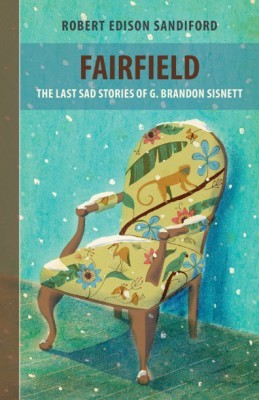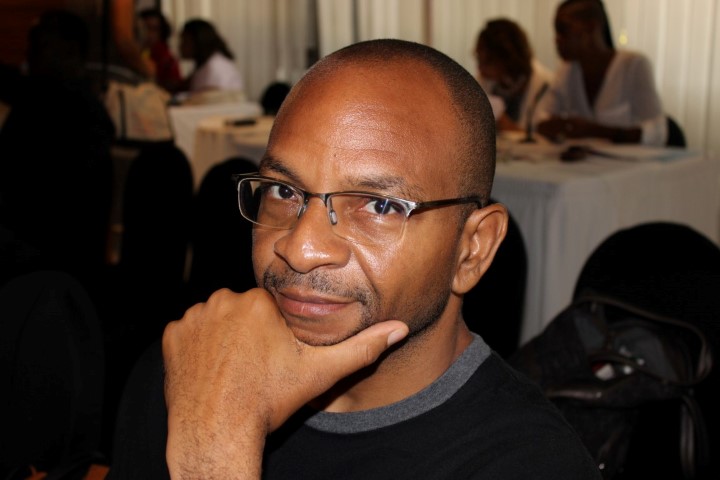The title of Robert Edison Sandiford’s short story collection, Fairfield: The Last Sad Stories of G. Brandon Sisnett, plays a number of tricks. It introduces the central conceit of the collection: the stories are presented as a manuscript written by a reclusive figure named G. Brandon Sisnett, who devoted his life to writing speculative fiction and political science. As readers are informed in a fictional foreword, it is only after Sisnett dies in isolation that the stories are discovered, and eventually published. The title also raises the spectral and ambiguous name Fairfield, a noun used in the stories to describe “city, state of mind, person, or idea,” and which reappears in these varying guises throughout the collection. But perhaps most importantly, the title wields either the promise or threat of stories imbued with sadness.
Yet, while this collection of thirteen brief stories is many things, sad never quite seems to be the right adjective. This assertion might seem surprising considering that, as the foreword states, one of the “true links between all the stories … is their preoccupation with death.”
I spoke with Robert Edison Sandiford and asked about his inspiration for the collection – the latest contribution to a career that has spanned fiction, graphic novels, journalism, and teaching. He cited issues of mortality and loss, explaining how he began writing the stories prompted by reflections on “death, how different people and different cultures handle death.” His young daughter and his own experience of aging deepened these questions, prompting him to think about old, or at least older … [noticing that] things change, your body changes … [there is] this relentless kind of process.”
As the stories emerged from these themes, the idiosyncratic structure came later, at the moment when, Sandiford recalls, “the stories started to ask, ‘How do we hang together?’” This question is a good illustration of how Sandiford speaks about his writing: meditatively, often punctuating his thoughts with rhetorical questions, more interested in musing and exploring than offering definitive statements. This question is also an important one; the stories in this collection are diverse and even disparate. Some plotlines include vignettes that draw their power from the subtlety with which they render seemingly unremarkable encounters: in “They Build Houses Here Now,” a former soldier, now selling vacation properties in Las Vegas, finds himself drawn to the opaque intimacy he witnesses between a husband and wife, while “Northern Lights” lyrically recreates a drunken night in Montreal as two long-time friends probe the raw edges of recent romantic trauma.
Other stories such as “Mobbed, By the BBC” and “Massiah” engage more directly with questions of politics and violence, both bodily and emotional. There is also a willingness to grapple with the fantastical and even the absurd: “Massiah” is set in a future reality where a cure has been discovered for aging, and the collection’s penultimate story, “Screen Saver,” narrates a sequence of events in which a man abruptly becomes trapped within a television set after stumbling against it.
What allows these stories to cohere and coexist, in addition to the thematic arches developed in the foreword, is Sandiford’s direct and unflinching approach to surprising or even outrageous details. “Screen Saver” offers a particularly compelling example of this unapologetically matter-of-fact narration when it presents its moment of crisis: “instead of breaking his face on the screen [he] fell into it and couldn’t get out.”

Fairfield
The Last Sad Stories of G. Brandon Sisnett
Robert Edison Sandiford
DC Books
$18.95
paper
160pp
9781927599358
Sandiford also cites the ability to imbue his stories with a strong sense of place as one of his major goals as a writer. The stories in Fairfield move deftly from Montreal to Las Vegas and Barbados, punctuated throughout by memories of the places where characters have been, or imagine themselves, as well as the places where they are. His own history is divided between Barbados and Canada, and we spoke while he was in Montreal for a brief visit. The issue of how place shapes experience and a sense of self is clearly a central question for him; I notice again and again a real desire to do justice to, and honour, the places he discusses.
There is a similar diversity to the style: when a story is narrated in the first person, or closely mirrors a particular point of view, Sandiford readily cultivates vivid voice and persona. This includes the careful use of dialect in “Thick ’n’ Thin” to capture the nuances and rhythms of spoken language. Perhaps unsurprisingly, when asked about his earliest memories of writing creatively, Sandiford recalls oral composition: “I remember walking home from school, coming up with stories, or the plots of stories.” He further roots his understanding of the creative process in notions of intimacy created through orality: “I remember my sister leaning in and asking, ‘Do you want to hear a secret? Do you want to hear a story?’”
The warmth of this intimacy is conveyed even at times of stylistic risk, such as in the challenging “Mobbed, By the BBC,” which is constructed from two overlapping sets of fragments, with the broken and ragged sentences mirroring the violence depicted in the plot. Despite the range of tones, places, and styles, the collection, unlike some other volumes of short fiction, stands up well to continuous reading, not demanding that each story be encountered as a discrete unit.
While the collection grapples continuously with the presence and possibility of death, it also reminds us that dying is inseparable from living. Moreover, it suggests the hidden selves that can emerge at the time of death, when the public surface of one’s life falls away. Sandiford explains that by presenting the collection through the framework of an author who was best known during his lifetime for producing non-fictional work, he wanted to explore the question of “which is more true? Which is more powerful? … The [work] people know about [or] the secret work we do, and the secret lives we lead?” “Work,” he continues, “might be very good and yet be unknown … there is the driving question of what people consider important. What is it that really matters to us?”
If, as the stories in the collection suggest again and again, we can never know the people around us in their entirety, then perhaps the question of what matters most can only be answered in full at the end of one’s life. Even here there is mediation and the possibility of loss. The foreword states that the thirteen stories presented in the collection are only a fragment of a total of thirty-two recovered at the time of Sisnett’s death. What is present is haunted also by what is not there. But what can be recovered, as those thirteen stories attest, is by turns tender, unflinching, and illuminating. Amid the detritus of lives, finished or still in progress, there are always stories, and if they are at times sad, they are also all we have. mRb







0 Comments